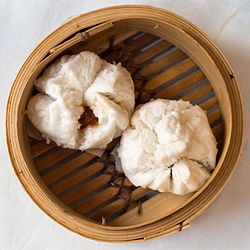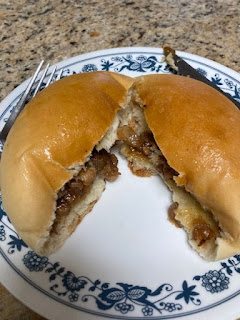Two weeks ago, Thursday Afternoon, during my mahjong session, Sabrina Monahan, Our THD Zumba Guru delivered to me a dozen huge barbecue pork buns( siopao) from a bakery in China Town in San Francisco for my gastronomic indulgence.
I had one that afternoon for my snack💚which ruined my appetite for my dinner of chicken wrapped in Bacon here at THD. But I had no regret. The huge buns were moist and delicious. Every bite is a journey of culinary delight.
I ordered a dozen (6 steamed and 6 baked). I plan on freezing them and just microwave one at a time when I have a cravings for the buns. It will be next month, when Sabrina can go to China Town in San Francisco for a reorder. In the Philippines, the barbecue buns are called Siopao. So what is Siopao.
Siopao is derived from the baozi, introduced by Hokkien Chinese immigrants to the Philippines during the Spanish colonial period. The name is derived from Philippine Hokkien sio-pau (simplified Chinese: 烧包; traditional Chinese: 燒包; Pe̍h-ōe-jī: Sio-pau; lit. 'hot bun').
Siopao is derived from the baozi, introduced by Hokkien Chinese immigrants to the Philippines during the Spanish colonial period. The name is derived from Philippine Hokkien sio-pau (simplified Chinese: 烧包; traditional Chinese: 燒包; Pe̍h-ōe-jī: Sio-pau; lit. 'hot bun'). Historically, the most popular siopao buns in Manila were the ones made by restaurateur Ma Mon Luk at the turn of the 20th century.
Siopao differs from the baozi in that it is much larger and is eaten held in the hands like a sandwich. It also uses different traditional fillings. The most common fillings are pork asado (indigenized braised version of the Cantonese char siu) and bola-bola (literally "meatball", a combination of pork, chicken, beef, shrimp or salted duck egg). Siopao uses leavened wheat flour and is traditionally steamed, but a baked version (also called "toasted siopao") can be baked directly in ovens without steaming. A popular variant called "fried siopao" fries the bottom of the siopao in a greased skillet after steaming. Another dish that evolved from the siopao is the asado roll, which uses regular bread dough and is baked.
Traditional siopao is also typically accompanied with a sweet and sour "siopao sauce" (made from cornstarch, soy sauce, sugar, garlic, and other ingredients), which is injected or spread unto the filling before eating. Plain ketchup (either tomato ketchup or banana ketchup) is also used in the same way. In contrast to the baozi which is eaten dipped in a soy sauce or vinegar mixture.
A unique variant from Siargao Island is the paowaw, a dessert bun which has a filling of bukayo(sweetened shredded coconut meat). Here's additional information from Wikipedia on Barbecued Pork Buns.
 | |
| Alternative names | Chashaobao, manapua, keke pua'a, chao pao |
|---|---|
| Type | Dim sum |
| Place of origin | Southern China |
| Serving temperature | Hot |
| Main ingredients | Pork |
| Variations | Baked or steamed |
| 501.2 kcal (2098 kJ) | |
| Cha siu bao | |||
|---|---|---|---|
| Simplified Chinese | 叉烧包 | ||
| Traditional Chinese | 叉燒包 | ||
| Jyutping | caa¹ siu¹ baau¹ | ||
| Cantonese Yale | chā sīu bāau | ||
| Hanyu Pinyin | chāshāo bāo | ||
| Literal meaning | barbecued pork bun | ||
| |||

Cha siu bao (simplified Chinese: 叉烧包; traditional Chinese: 叉燒包; pinyin: chāshāo bāo; Jyutping: caa1 siu1 baau1; Cantonese Yale: chā sīu bāau; lit. 'barbecued pork bun') is a Cantonese baozi (bun) filled with barbecue-flavored cha siu pork. They are served as a type of dim sum during yum cha and are sometimes sold in Chinese bakeries.
Varieties
There are two major kinds of cha siu bao: the traditional steamed version is called 蒸叉燒包 (pinyin: zhēng chāshāo bāo; Jyutping: zing1 caa1 siu1 baau1; Cantonese Yale: jīng chāsīu bāau) or simply 叉燒包(chāshāo bāo; caa1 siu1 baau1; chāsīu bāau), while the baked variety is usually called 叉燒餐包 (chāshāo cān bāo; caa1 siu1 caan1 baau1; chāsīu chāan bāau). Steamed cha siu bao has a white exterior, while the baked variety is browned and glazed.
Meanwhile here's a list of most Popular Filipino Meriendas ( Snacks). Makes me Hungry, Again!





No comments:
Post a Comment